Work
Work Definition: Work is said to be done when an object is displaced from its initial position under the action of a force. Work is measured as the scalar product of the applied force and the displacement of the object.
Let \(\vec{F}=\overrightarrow{O B}\) = force acting on a particle and \(\vec{s}=\overrightarrow{O A}\) corresponding displacement of the particle.
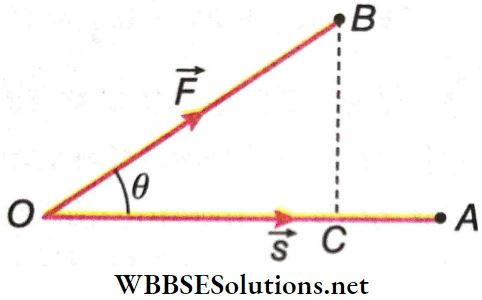
Then, by definition, the work done is W = \(\vec{F}\) \(\vec{s}\)…..(1)
If θ = ∠BOA = angle between the force and the displacement vectors, then from the property of the scalar product, we have W = Fscosθ……(2)
From the figure we get, \(F \cos \theta=O B \cdot \frac{O C}{O B}=O C\) = component of the force \(\vec{F}\) along the direction of the displacement \(\vec{s}\).
Hence, from equation (2), it may be written that, work done = displacement x component of force along the direction of displacement
If the components of \(\vec{F}\) and \(\vec{s}\) are known, equation (1) can be expressed as,
W = \(\left(F_x \hat{i}+F_y \hat{j}+F_z \hat{k}\right) \cdot\left(s_x \hat{i}+s_y \hat{j}+s_z \hat{k}\right)\)
= \(F_x s_x+F_y s_y+F_z s_z\)
It is very important to note that, force and displacement are both vector quantities, but their product, work, is a scalar quantity.
Work Discussions:
1. Force Without Displacement: If an object is not at all displaced under the action of a non-zero force \(\vec{F}\), then work done is considered to be zero,
i.e., if s = 0 but F≠ 0, then
W = Fscosθ = Fcosθ x 0 = 0
2. Displacement Without Force: If an object is displaced in the absence of any force acting on it, i.e., if s≠0 when F = 0, we find from equation (2), W = 0. For example, an object moving with uniform speed in a straight line maintains its state of motion in the absence of any external force on it (Newton’s 1st law).
But its displacement is not zero, because it is actually moving and as a result changing its position. In this case, there is no work done, only because F = 0.
3. No-Work Force: If the force and the displacement vectors are perpendicular to each other, then θ = 90° or cosθ = 0. So, from the equation (2), we have W = 0. In such cases, the force acting on an object is called a no-work force.
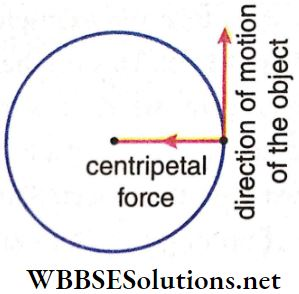
For example, an object in a uniform circular motion is displaced along the tangent of the circle, whereas the active force, called the centripetal force, acts in the radial direction. As the tangential and the radial directions are perpendicular to each other, the centripetal force is a no-work force.
Sign Convention Of Work: Work done (W) is conventionally defined as W = \(\vec{F}\) – \(\vec{s}\) = Fscosθ….(3)
The different values of cosθ give rise to different cases:
- If θ lies between 0 and 90°, cosθ is positive. So, from equation (3), the work done is positive.
- If θ lies between 90° and 180°, cosθ is negative. So, from equation (3), the work done is negative.
It should be mentioned that the opposite convention, W = –\(\vec{F}\)– \(\vec{s}\), may also be used. No error will occur if this alternative relation is consistently followed throughout.
In many problems, we need to deal only with the absolute value of work done. Then, the positive or negative sign of W would not be important.
Sign Convention Of Work Discussion: When an object is displaced in a direction opposite to the force acting on it, it is said that the work is done against the force. In this situation, there must exist an external agent that is responsible for the displacement of this object against the force.
Lifting of an object upwards against the downward force of gravity acting on it, the motion of an object on a rough surface against the force of friction, etc., are examples of this type of work. In these cases, usually, some person or some machine acts as the external agent.
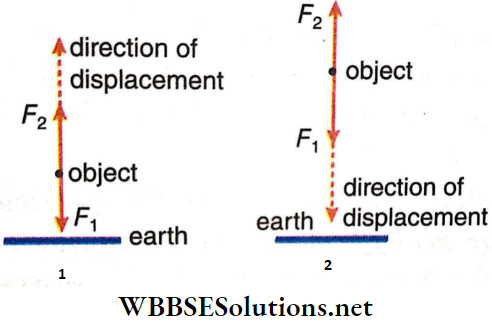
Let us take the example of lifting an object against gravity. This can be explained in two ways:
- The external agent (which lifts the object) does positive work on the object by applying a force \(\vec{F}_2\) or
- Gravity \(\vec{F}_1\) does negative work on the object.
Similarly, when an object falls under the action of gravity and an external agent opposes the motion, it can also be explained in two ways:
- The external agent does negative work on the object or
- Gravity does positive work on the object.
Work Done On A System Of Bodies: The application of a force on a system, comprising a number of bodies, may produce different displacements for different bodies within the system, In such cases, to calculate the work done, the displacement of the point of application of the force is considered.
Hence, in this case, work done = force on the system of bodies x displacement of the point of application
Work Done By A System Of Forces: Since work is a scalar quantity work done due to a number of forces acting on a body is the algebraic sum of the work done due to each of the forces. The resultant of the forces produces the same amount of work.
Let a system comprising three forces act on a body, and the work done due to this system be W. Work done due to the individual forces are, w1, w2, and w3. The resultant of the system of forces is \(\vec{F}\) and the displacement of the body is \(\vec{s}\). Hence W = w1 + w2+ w3 = \(\vec{F}\) · \(\vec{s}\)
Work Done By A Varying Or A Variable Force: So far we have considered the work done by a force that is constant both in magnitude and direction. But often the force doing work is variable. A varying force means, a force whose magnitude or direction or both changes continuously.
- For example, when a rocket is fired upwards from the Earth, the force required to keep the rocket moving away from the Earth is not constant, it continuously decreases.
- Similarly, when a spring, whose end is fixed to a rigid support, is stretched by a force through a small distance x then the restoring force F developed in the spring increases with x.
- Let us consider a variable force F to be acting on a particle. Under the influence of this force, the particle is displaced along the x-axis from the initial position xi to the final position xj.
- The x-component of the force is denoted by Fx. In this case, the work done cannot be simply stated by W = Fx(xf– xi). This equation is applicable when the applied force is a constant.
- Here the force F varies with x and hence both F and Fx are functions of x. To calculate the work done in this case, the interval xi to xf is divided into a large number of small displacements Δx, so that Fx can be assumed to be constant over this displacement Δx.
- Hence for a very small displacement Ax, work done can be considered to be ΔW = FxΔx.
- This can also be considered to be the area of the shaded region.
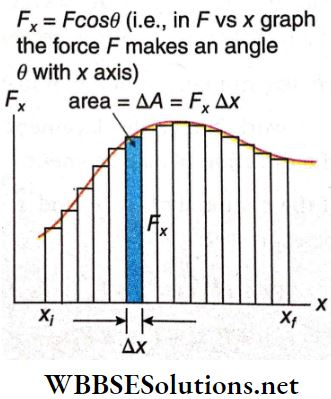
Therefore total work done when the particle is displaced from the initial position xi to the final position xf is given by the relation
W = \(\sum_{x_i}^{x_f} F_x \Delta x\)…(1)
If \(\Delta x \rightarrow 0\), then \(\lim _{\Delta x \rightarrow 0} \sum_{x_i}^{x_f} F_x \Delta x=\int_{x_i}^{x_f} F_x d x\)….(2)
From (1) and (2) we obtain, \(W=\int_{x_i}^{x_f} F_x d x\)
In this case, the total work done can be considered to be the area enclosed by the curve between xi and xf on the x-axis.
Work Done On A Particle Moving Along A Curved Path: Let us consider a particle being moved along the curve AB as shown by a force \(\vec{F}\) which continuously changes in magnitude as well as in direction.
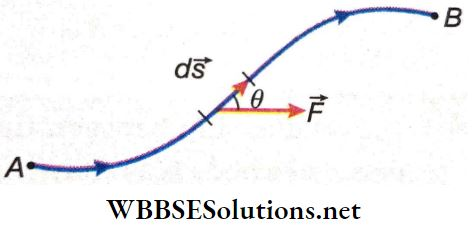
According to the diagram, if \(\vec{ds}\) is a small displacement of the particle under the action of the force, then the total work done in displacing the A particle from A to B is
W = \(\int_A^B \vec{F} \cdot d \vec{s}=\int_A^B F \cos \theta d s\)
It is to be noted that in this integration, neither F nor θ is a constant.
Graphical Representation Of Work: The relationship between forces acting on a body and its displacement can be represented in a force-displacement graph.
For A Constant Force: If the displacement of a body is s0 under the action of a constant force F0, we get a straight line graph AB. AB is parallel to the x-axis as F0 is constant.
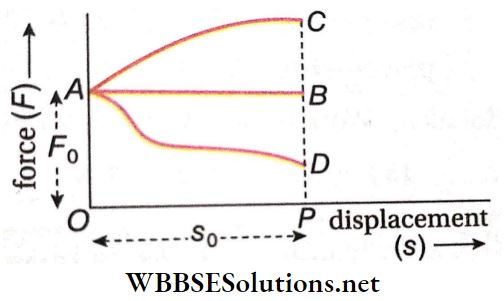
Obviously, the area under the graph, ABPO, is equal to F0S0 which is the magnitude of the work done.
For A Varying Force: If s0 is the displacement of a body under a varying force, the force-displacement graph is not a straight line, but a curved line like AC or AD. In these cases also, it can be proved that the area under the curve (AC or AD) gives the work done.
Hence, work done corresponding to graph AC = area ACPO; work done corresponding to graph AD = area ADPO.
Thus, in general, work done = area under the force-displacement graph.
Absolute Units And Dimension Of Work: Work done = force x displacement of the body. Hence, a unit of work depends on units of force and displacement.
A unit work is said to be done when a unit force acting on a body produces a unit displacement along the direction of the force.

Dimension: Dimension of work = dimension of force x dimension of displacement = MLT-2 x L = M2T-2
Unit 4 Work Energy Power Chapter 1 Work And Energy
Work Numerical Examples
Example 1. To displace a body by 50 m, 150 J of work is done. What is the force applied in the direction of the displacement?
Solution:
Work done, W = Fs, where W = 150 J, s = 50 m
∴ 150 = 50F or, F = 3 N .
Example 2. A body of mass 10 kg is raised by 5m. What is the work done?
Solution:
Force, F= mg = 10 x 9.8 = 98 N ; displacement, s = 5 m
∴ Work done, W= Fs = 98 x5J = 490 J
Example 3. A cycle with the rider has a total mass of 80 kg; it rolls down 60 m on a plane of inclination 30°. What is the total work done by gravity on the cycle?
Solution:
Force acting vertically downwards, F = 80 kg-wt = 80 x 9.8 N
Displacement, s = 60 m
The angle between force and displacement, θ = 60°
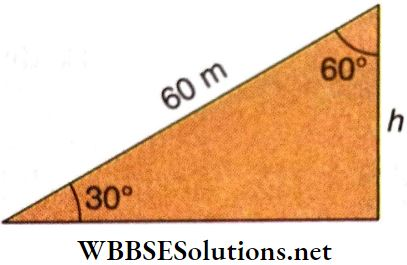
∴ W=Fscosθ
= (80 x 9.8) x 60 x cos60°
= 80 x 9.8 x 60 x 0.5 = 23520 J
Example 4. A man of mass 100 kg climbs up a ladder of length 10 m. The ladder makes an angle 60° with the horizontal. Find the work done by the man against gravity in climbing up the ladder, [g = 9.8 m · s-2]
Solution:
Work done to climb up the ladder by 10 m is equivalent to the work done to climb up a vertical height h.
Here, \(\sin 60^{\circ}=\frac{h}{10}\)
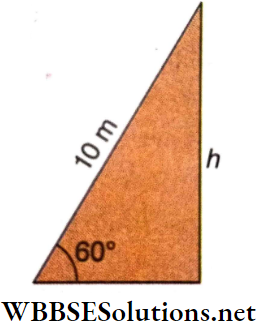
or, \(h=\frac{10 \sqrt{3}}{2}\)
∴ Work done, \(W=m g \times h\)
= \(100 \times 9.8 \times 5 \sqrt{3}=8487.04 \mathrm{~J}\).
Example 5. A body is constrained to move along the z-axis is subject to a constant force F = \((-\hat{i}+2 \hat{j}+3 \hat{k}) \mathrm{N}\). Calculate the work done by this force in moving the body a distance of 4m along the z-axis.
Solution:
Displacement, \(\vec{s}=4 \hat{k} \mathrm{~m}\)
Force, \(\vec{F}=(-\hat{i}+2 \hat{j}+3 \hat{k}) \mathrm{N}\)
∴ Work done, W = \(\vec{F} \cdot \vec{s}=(-\hat{i}+2 \hat{j}+3 \hat{k}) \cdot 4 \hat{k}\)
= \(-4 \hat{i} \cdot \hat{k}+8 \hat{j} \cdot \hat{k}+12 \hat{k} \cdot \hat{k}\)
= \(0+0+12 \cdot 1=12 \mathrm{~J} .\)
Example 6. A force F-acting on an object varies with distance x as shown here. The 2 force is in N and x in m. What is the amount of work done by the force in moving the object from x = 0 to x = 6m?
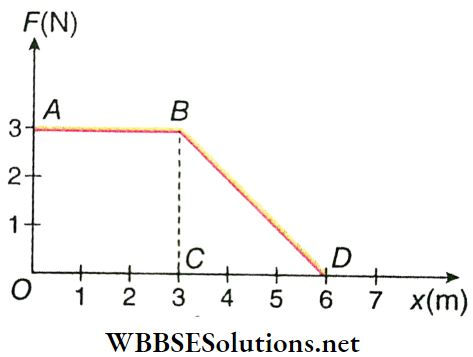
Solution:
Work done, W = area of the rectangle OABC + area of the triangle BCD,
= 3 x 3 + 1/2 x 3 x 3 = 13.5J
Example 7. The relationship between the force F and the position x of a body is as shown. What will be the amount of work done in displacing the body from x = 1 m to x = 5m?
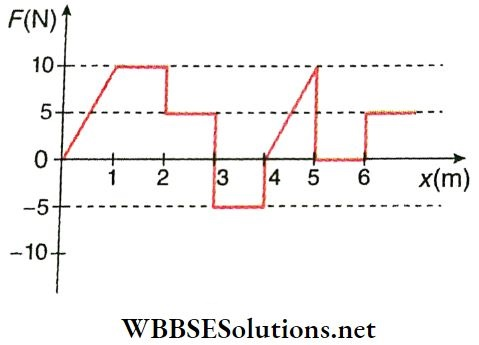
Solution:
Work done,
W = 10 x 1 5 x 1 + (-5 x 1) + 1/2 x 1 x 10
= 10 + 5 – 5 + 5
= 15J
Example 8. A position-dependent force F = (7 – 2x + 3x²) N acts on a body of mass 2 kg and displaces it from x = 0 to x – 5 m. Determine the amount of work done in i joule.
Solution:
Work done,
W = \(\int F d x=\int_0^5\left(7-2 x+3 x^2\right) d x\)
= \(\left[7 x-x^2+x^3\right]_0^5\)
= \(7 \times 5-5^2+5^3=35-25+125=135 \mathrm{~J}\)

